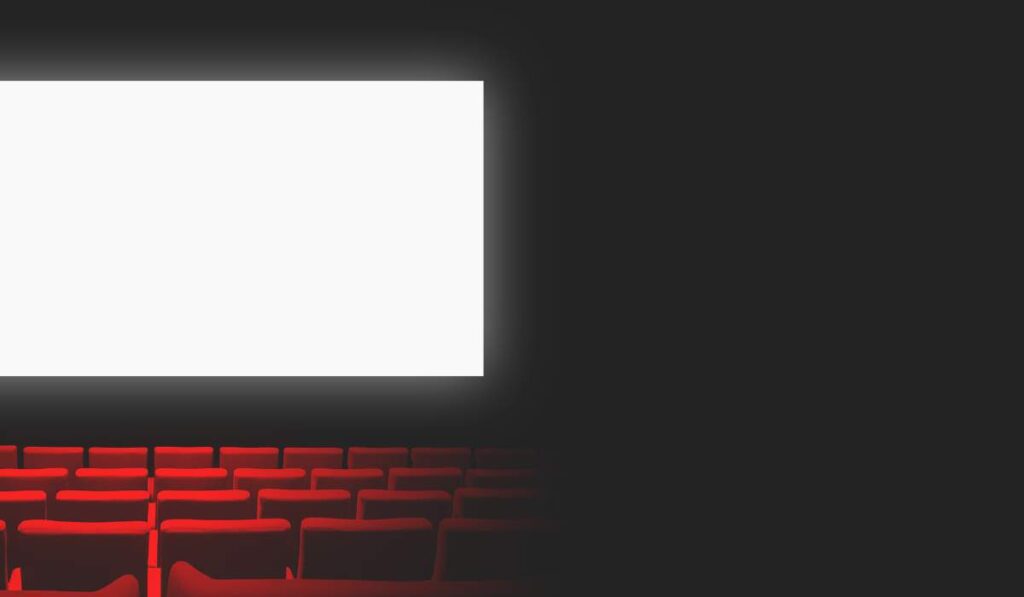Whether you’re setting up a home theater or classroom presentation space, choosing the right projector screen material is an important decision.
Different materials offer variations in viewing quality, viewing angles, installation flexibility, and price.
Let us explore the commonly used projector screen materials so that you can determine which option is best suited to your specific needs and space.
What Projector Screen Material Is Best?

When choosing a projector screen, the surface material is one of the most important factors for optimizing image quality.
Different materials have advantages and tradeoffs based on room lighting, viewing angles, and other considerations.
Here is an overview of common projector screen types:
Matte White
Matte white screens have a flat white surface that diffuses light evenly in all directions. This makes them a versatile choice that works well in a variety of lighting conditions. The diffuse surface avoids hotspots and provides a wide viewing angle.
Matte white is ideal for moderately lit rooms and gives a bright, vibrant image. It’s a particularly good match for LCD and DLP projectors.
Matte white screens come in different gain levels, typically around 1.0 to 1.3, which refers to the amount of light reflected back. Lower gains are better suited to dark rooms, while higher gains work well in ambient light.
3D Projector Screen
To properly view 3D content, the screen must preserve the polarization of light from the projector. 3D screens use silver-coated material that maintains polarization. This allows the left and right images projected for each eye to be directed correctly.
3D screens also have a high gain, usually around 2.0 or higher. This boosts the 3D brightness since the polarized glasses filter out so much light. A high-gain angular-reflective surface also enhances the 3D effect.
3D screens can be paired with passive polarizing glasses or active shutter glasses. They are essential for the best 3D image.
High Contrast Gray
Gray screens offer better contrast compared to white screens. The darker gray surface absorbs ambient light, reducing washout from overhead lighting or windows.
This allows the image to really pop in moderate ambient light. Gray screens typically have gains between 0.7 to 1.3. The lower gain helps preserve contrast while still providing enough brightness.
Deeper blacks are possible with a gray screen. It brings out detail in dark scenes and shadow areas. High-contrast gray is ideal for media rooms or multipurpose spaces where lighting conditions are not ideal.
Acoustic Transparent
Acoustic transparent screens allow speakers to be placed directly behind the screen. Micro-perforations in the material let sound pass through clearly. This creates a seamless viewing experience without compromising audio quality.
The tiny holes are small enough that they are not visible from the viewing distance. Acoustic transparent screens have an attractive flat surface and wide viewing angle.
They can be paired with the latest ultra-short throw projectors placed just inches from the screen. An acoustic transparent screen conceals the speakers for a clean, integrated appearance.
Rear Projection
For rear projection, the image is beamed onto the back of the screen. The screen material diffuses the light forward to the viewer. Rear projection screens create deeper blacks since light is not lost through the substrate.
A finely textured surface provides uniform diffusion with a wide viewing angle and no hot-spotting. Rear projection screens can be paired with ultra-short throw projectors or longer throw units mounted behind the screen wall.
Screens are available in various gains and sizes. Rear projection creates an immersive viewing experience and discreet integrated look.
Fresnel
Fresnel screens use a finely grooved surface that refracts and focuses projected light. This allows them to maintain image brightness from a steep projection angle.
Fresnels work well in spaces with restricted mounting positions. The grooved surface acts like small prisms concentrating light evenly across the viewing field.
Fresnel screens have a narrower viewing angle compared to matte white. But they can achieve high gain levels up to 3.0 or 4.0.
Fresnels need precise alignment to avoid moiré interference patterns. They allow bright vivid projection from steep above or below angles.
Ambient Light Rejecting (ALR)
ALR screens use materials engineered to filter ambient light reflections. Multi-layer optics absorb surrounding light while reflecting image light back to the viewer. This allows clear bright projection even in daylight or brightly lit rooms.
ALR screens have layers of tiny louvers that block ambient light from washing out the image. They work best when paired with UST projectors positioned close to the screen.
ALR screens can achieve incredibly high contrast ratios even with the lights on. They make projection possible in lighting conditions that render other screens unwatchable.
Perforated screens
Perforated screens contain thousands of tiny holes in the projection surface. These micro-perforations make the screen acoustically transparent for speakers behind the screen. But perforated screens also provide additional benefits.
The holes help reduce moiré interference patterns and pixelization from the projection. This results in a smoother, artifact-free image quality.
Perforated screens provide a wide viewing angle and controlled diffusion thanks to the perforations. They allow both excellent audio and great projected image quality.
DIY Screen Material
For DIY screens, specialty projection screen material can be purchased and paired with custom framing. Materials like vinyl, polyester, or fiberglass provide good projection quality. Matte white, gray, and high-contrast materials are available in rolls or sheets.
DIY screen material is an affordable way to create a screen in any custom size and shape. Quality projector paint is also available to coat walls for a budget projection surface.
With DIY material, it’s easy to build a screen that fits your exact projector setup and room dimensions.
Glass Beaded
Glass beaded screens offer extremely high gain levels around 2.5 to 4.0. A surface coated with tiny glass beads retroreflects projected light uniformly back to the viewer. This creates a remarkably bright picture perfect for 3D projection.
Glass beaded screens have a very narrow viewing angle and must be paired with a projector properly aligned to the screen.
They excel at producing 3D immersion and astonishing colors. But the viewing angle is too narrow for larger rooms with multiple seating areas. Glass beaded screens deliver incredible screen gain performance.
Factors to Consider in Choosing the Best Material for a Projector Screen
Selecting the right projector screen material is crucial for achieving optimal image quality. The screen surface greatly impacts picture brightness, contrast, viewing angle and ambient light handling.
Here are some key factors to take into account when choosing material for a projector screen:
Ambient Light
The amount of ambient light in the room from windows, overhead lighting, or lamps is a primary consideration.
In darkened rooms with little ambient light, matte white screens work very well. The matte surface diffuses light evenly across a wide viewing angle. But in rooms with lots of light during daytime viewing, an ambient light rejecting (ALR) screen is better.
ALR screens use layered optical coatings to reflect image light while absorbing ambient light. This prevents washout and loss of contrast in bright rooms.
Screen Gain
The screen gain, or reflectivity, determines how bright the image will be. Lower gain screens around 1.0 work well in dark rooms and absorb ambient light reflections.
Higher gain screens up to 2.5+ reflect more light back towards the viewer for ultra-bright projection. High gain is ideal for 3D screens.
But gain also impacts viewing angle – higher gain gives a brighter image but over a narrower viewing cone.
Viewing Angle
This refers to the optimal area for viewers to see the screen. Wider viewing angles allow more flexible seating arrangements.
Matte white screens have a diffused surface that scatters light for a viewing angle of up to 160 degrees or more.
Screens with optical coatings like ALR, acrylic, or lenticular surfaces provide a narrower 40-50 degree viewing cone.
Acoustic Transparency
For speakers directly behind the screen, acoustic transparency is needed. Micro-perforated screens allow sound to pass through clearly.
Special materials like Seymour’s Center Stage XD and Stewart Filmscreen’s Phantom HALR offer both ambient light rejection and acoustic transparency.
Contrast Enhancement
Deeper black levels and high contrast create pleasing image quality. Gray screens offer better contrast than white in ambient light conditions.
High-contrast gray screens like Elite Screens’ Cinegray absorb stray reflections while still producing enough brightness.
Resolution
Screen materials impact perceived resolution and pixelation. Matte white diffuses light for softer image quality, while high-gain glass beaded screens can exaggerate the screen door effect.
Finer weave fabrics like Stewart Filmscreen’s Tiberius White minimize moire interference for enhanced 4K and 8K projection.
Projection Type
Rear projection screens diffuse light coming from behind for seamless built-in setups. Acoustic transparent materials are designed for ultra-short throw projectors positioned just inches from the screen.
Fresnel lens screens accommodate steep projection angles from above or below.
Budget
Projector screen material price varies widely from basic matte white paint under $10 per gallon to ultra high-end ALR screens over $1000.
Motorized screens also add cost. DIY screen material offers an affordable solution.
Size Needs
If an exceptionally large screen is needed, beaded or high-gain surfaces can provide extra brightness for big screen immersion.
Tab-tensioned materials allow much larger screens without waves.
Conclusion
There is no single “best” projector screen material, as the right choice depends on your unique viewing environment and preferences.
By considering factors like brightness, viewing angles, screen size, and budget, you can select the material that will provide the optimal experience for your projector setup.
Choosing the right screen is key to enjoying clear, high-quality projections.

Paul Joseph is a seasoned writer and projector expert with a knack for troubleshooting and fixing projector issues. Through his informative articles, he shares valuable insights on projector maintenance, optimization, and reviews of top projector models. With a passion for technology, Paul remains dedicated to empowering readers in their projector journey.